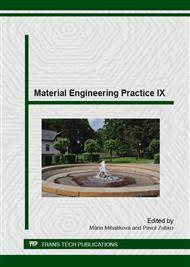p.151
p.157
p.161
p.165
p.169
p.174
p.177
p.182
p.186
Flexural Properties of FDM Prototypes Made with Honeycomb and Sparse Structure
Abstract:
The rapid prototyping (RP) process is capable of building parts of any complicated geometry in least possible time without incurring extra cost due of absence of tooling. Fused deposition modeling (FDM) is a fast growing RP technology due to its ability to build functional parts having complex geometrical shape in reasonable time period. The quality of built parts depends on many process variables. The presented study focus on assessment of mechanical property flexural strength of part fabricated using fused deposition modeling (FDM) technology. The 3-point bending test was used, to determine flexural strength. Samples were made of polycarbonate on Fortus 400 mc machine from polycarbonate with slice height 0.127mm. The experiment was focused on influence of air-gap size between fibers and number of outline contours on selected mechanical properties of FDM prototypes determined 3-point bending test. The results show possibility to obtain weight reduction in printed parts with sparse structure with sufficient flexural strength and with reduced build time, compared to structure printed with default machine setting,. To obtain optimal processing parameters for 3D printing prototypes, it is necessary to execute further experiments, which could verify gathered results.
Info:
Periodical:
Pages:
169-173
Citation:
Online since:
December 2014
Authors:
Keywords:
Price:
Сopyright:
© 2015 Trans Tech Publications Ltd. All Rights Reserved
Share:
Citation:


